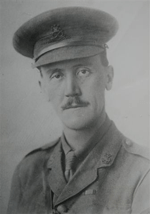Edward Elers Delaval Henderson facts for kids
Quick facts for kids
Edward Elers Delaval Henderson
|
|
|---|---|
 |
|
| Born | 2 October 1878 Shimla, British India |
| Died | 25 January 1917 (aged 38) River Hai, near Kut, Mesopotamia |
| Buried |
Amara Military Cemetery
|
| Allegiance | |
| Service/ |
|
| Years of service | 1900–1917 |
| Rank | Lieutenant Colonel |
| Unit | North Staffordshire Regiment |
| Commands held | 9th (Service) Battalion, Royal Warwickshire Regiment |
| Battles/wars | World War I † |
| Awards | |
Lieutenant-Colonel Edward Elers Delaval Henderson (2 October 1878 – 25 January 1917) was a very brave British soldier. He received the Victoria Cross, which is the highest award for courage in the face of the enemy. This special medal is given to soldiers from the United Kingdom and Commonwealth countries. He earned this medal during World War I.
Contents
Early Life and Military Start
Edward Henderson was born on October 2, 1878, in Shimla, which was part of British India at the time. He went to school at Dunstable Grammar School.
In 1900, when he was 22, he joined the West India Regiment as a Second lieutenant. He later served with the Northern Nigeria Regiment. In 1902, he was promoted to Lieutenant.
Earning the Victoria Cross
By 1917, Edward Henderson was 38 years old. He was a Major and acting Lieutenant Colonel. He was part of The North Staffordshire Regiment (The Prince of Wales's) but was leading the 9th Battalion of the Royal Warwickshire Regiment.
His amazing act of bravery happened on January 25, 1917. This was during the First World War, near the River Hai in Mesopotamia, close to a town called Kut.
A Critical Moment in Battle
Lieutenant-Colonel Henderson's battalion was in a tough fight. They were in their front-line trenches, which were under heavy enemy fire. Many soldiers in his battalion were hurt.
Then, the enemy launched a strong counter-attack. They managed to break through the British lines in several places. The situation became very dangerous for the soldiers.
Henderson's Incredible Bravery
Even though he was shot in the arm, Lieutenant-Colonel Henderson did something extraordinary. He bravely jumped onto the top of the trench wall. He then walked forward alone, ahead of his battalion.
He was cheering on his men, even though the enemy was firing intensely. He advanced over 500 yards of open ground. He was wounded again, but he kept going.
He continued to lead his soldiers with great courage. Finally, he led them in a bayonet charge, and they captured the enemy position. He was wounded two more times during this action. Sadly, he died from his injuries after being brought in.
He was buried in the Amara War Cemetery.
The Victoria Cross Medal
The Victoria Cross medal awarded to Edward Henderson is a very important piece of history. You can see it on display in the Lord Ashcroft Gallery. This gallery is located at the Imperial War Museum in London.
See also

